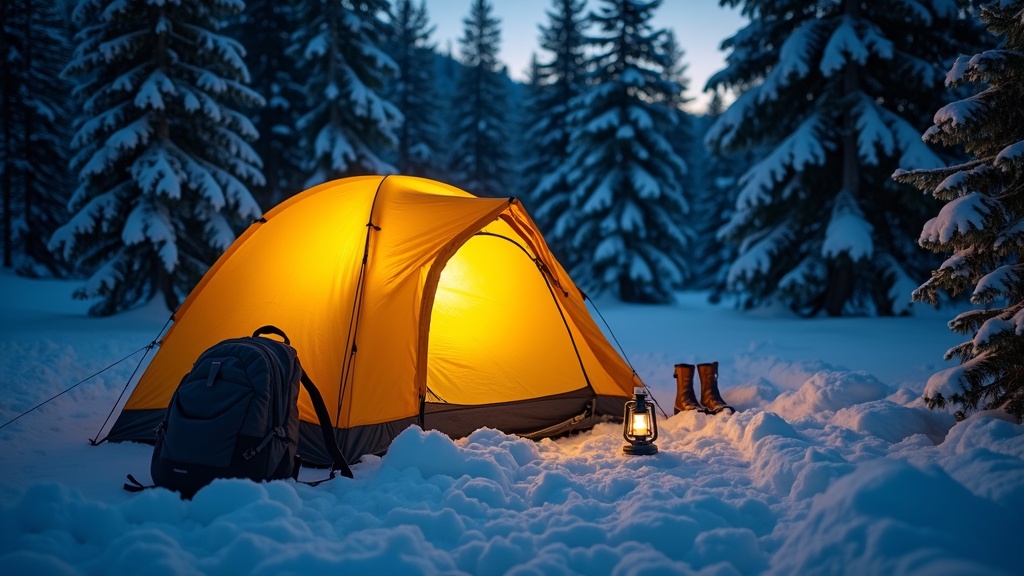Winter camping is a different beast compared to heading out during the warmer months. Cold temperatures, snowy terrain, and shorter daylight hours mean you’ll need a few extra tricks to make your adventure a whole lot more comfortable and safe. I’ve spent plenty of nights in frosty tents, picking up tips that truly make the experience way more enjoyable. Whether you’re planning your first subzero trip or aiming to sharpen your winter camping skills, these pointers cover all the basics and add a few pro move extras.

Must-Have Gear for Winter Camping
Heading into the cold without the right gear sets you up for a tough time. Temperatures can drop fast, and snowy conditions add extra challenge. Grabbing the right essentials keeps you warm and comfortable through it all.
Winter camping adds a bit more bulk than summer trips. The basics—tent, sleeping bag, stove—should be selected with cold weather in mind. For example, a sleeping bag rated for frigid temps and an insulated sleeping pad (or two) make a huge difference when the mercury dips.
Here’s the winter camping checklist I always turn to:
- Four season tent: Stronger poles and less mesh compared to regular tents, so these handle snow and wind much better.
- Sleeping bag rated for cold: Choose bags meant for at least 10°F lower than what you expect, ideally with down or top-notch synthetic fill.
- Sleeping pads: More insulation between you and the frozen ground is key. Two pads—one foam, one inflatable—work great.
- Layered clothing: Wool or synthetic base layers, warm midlayers (fleece, puffy jackets), and waterproof outerwear lock in warmth.
- Camp stove good in the cold: Some stoves (like white gas) do better when it’s freezing compared to many canister models.
- Extra fuel: You’ll burn through fuel melting snow and staying warm, so bring more than you think you need.
- Headlamp and extra batteries: Cold weather zaps batteries, so keep them warm overnight and pack extras just in case.
Adding a few luxury items such as a warm sleeping bag liner or rechargeable hand warmers can seriously boost your comfort level. Don’t forget a foam sit pad for hanging around camp—it’s a gamechanger during chilly meal breaks and for putting on boots.
Prepping for Your Winter Trip
Getting ready is everything when you’re heading out in winter. A bit more planning now saves you a ton of hassle (and chattering teeth) later.
If you’re new to cold weather camping, start with short trips close to home. That way it’s easy to head back if something isn’t right. Always watch weather forecasts and avalanche reports, especially if you’re in the mountains.
- Map out your route: Shorter days mean you’ll have less daylight for hiking and setting up camp. I always set up before dark so I’m not wrestling frozen gear by headlamp.
- Track down snow and avalanche reports: Check local avalanche centers or weather services daily—they update info each morning.
- Tell someone your plan: Let a buddy know where you’ll be and when you’re coming back. Cell service is unreliable in the wild.
- Do a test setup: Build your camping setup in your backyard. This quick practice gives you a sense of how everything functions and if anything is missing.
Put your phone, electronics, and water filters in your sleeping bag at night to keep them from freezing. Prepare food for quick meals—motivation to prep complex dinners drops fast when it’s snowing sideways.
Basic Winter Camping Tips for Comfort and Safety
Once snow is falling, these simple tips help you stay warm and make the most of your time outdoors.
- Stay dry: Wet and cold is rough. Ventilate your tent to reduce condensation and change out of sweaty clothes as soon as you can.
- Eat more calories: Staying warm burns a lot of energy. Snack throughout the day, focus on fats and carbs, and keep those calories coming.
- Layer smart: Adjust clothes before you get sweaty or cold. It’s easier to maintain comfort than fix chills or dampness.
- Hot drinks often: Brew tea, cocoa, or soup regularly. It does wonders for morale and core body temperature.
- Insulate your water bottles: Store them upside down at night in your bag—ice forms at the top first, so you can still squeeze out a drink if the bottom freezes.
For extra nighttime warmth, fill a Nalgene with hot water, seal it tight, and put it in your sleeping bag (inside a sock for comfort). It’ll keep you warm for hours and you’ll wake up to water that’s not frozen.
Challenges to Be Ready For
Winter camping comes with its hurdles, but a little knowledge goes a long way toward keeping things smooth. Here are a few obstacles I’ve faced (and my fixes):
- Frozen boots: Put them in a stuff sack inside your sleeping bag at night. In the morning, you avoid the frozen-boot dance.
- Condensation in your tent: Keep vents open for airflow and do a quick wipe down in the morning to avoid soggy sleeping bags.
- Melting snow for water is slow: Use a bigger pot, plenty of fuel, and filter out twigs or debris with a coffee filter for much faster water prep.
- Staying warm while sitting around: Pack an insulated seat or foam tile and dry socks or camp booties for downtime.
Boot and Gear Care
Frostbite from cold boots or stiff gloves can wreck your trip. Always dry out liners each night (tuck them into your armpit or near your stove), and sleep with boots between your bag and liner. When hands get too cold to function, chemical warmers inside gloves help keep dexterity going strong.
Managing Condensation
Cold air outside and your warm breath inside adds frost all over the tent walls. I keep a small towel handy to wipe it down in the morning, and leave my tent doors partially open for a light breeze when it’s not too windy. Less moisture inside equals a drier, toastier tent.
Water Collection
Snow is a handy resource, but eating it straight chills your body quick. Melt it with your stove, but keep in mind you need a lot to get just a little water. Pour a bit of liquid water in the bottom of the pot before adding snow. If you camp near a stream, have a backup water source and filter or boil before drinking.
Winter Camping Tricks That Make Life Easier
On my coldest trips, small tricks have made all the difference. Here are a few hacks I go back to, time and time again:
- Deadman snow anchors: In deep snow, bury stuff sacks full of packed snow attached to your guy lines as tent anchors—these help more than typical stakes.
- Use a foam pad for boots: Placing a foam pad on the ground lets you swap footwear without freezing your feet.
- Prewarm breakfast and clothes: Sleep with your breakfast bars and socks in your sleeping bag so mornings are less painful.
- Organize your basics: Keep a lamp, snacks, and your toilet kit in easy-to-reach places to avoid digging around in the cold.
- Pee bottle: Not glamorous, but you’ll skip midnight outings when it’s icy. Mark it clearly—no surprises in that dark tent!
What Beginners Should Focus On
Winter camping can feel overwhelming, but keeping things simple works best. Here’s what I’d double down on if you’re starting out:
- Stay warm and dry: This is rule one. Invest in your sleep system and layers above all else.
- Stick close to home: Choose short routes or established campgrounds until you’re confident in your skills and gear.
- Keep meals easy: You don’t need restaurant-quality food; just reliable fuel, a hearty meal, and a foolproof water plan.
- Learn from others: Team up with veterans or check out online forums and winter hiking groups. You’ll get great advice fast and avoid rookie mistakes.
Making small gear upgrades over time—better gloves, insulated containers, smarter packing—will slowly make your cold weather kit more comfortable. Once you settle in, start customizing and fine-tuning for your style.
- Make downtime fun: Bringing a book, playing cards or a small game turns those long winter nights into some of my favorite camp memories.
Frequently Asked Questions
I get asked all sorts of things about winter camping. Here are some of the most frequent:
Q: Is it safe to sleep in a tent in subzero temperatures?
A: With a solid game plan and the right gear, absolutely. Use a sleeping bag designed for cold, double up on sleeping pads, and always switch to dry gear for sleep.
Q: How do I keep my phone and batteries alive in the cold?
A: Store them in your sleeping bag overnight and away from the wind during the day. Lithium batteries last much longer in cold weather than alkaline ones.
Q: What’s the best way to stay warm at night?
A: Eat a hot meal before bed, keep a water bottle in your bag, and wear only dry clothes to sleep. Don’t cinch your sleeping bag too tight; wiggle room helps heat move around.
Q: How do you handle bathroom breaks when it’s freezing?
A: Go before lights-out, and use a pee bottle if needed. For number two, bring a tiny trowel and waste bags. Always pack out waste.
Final Thoughts on Winter Camping
With good planning and the right approach, winter camping becomes less about dealing with discomfort and more about soaking in quiet snow-filled landscapes and peaceful, silent nights. Savor the satisfaction of sipping hot cocoa in the solitude of a snowy camp, knowing you’ve stepped up to the challenge. Good gear, smart choices, and flexibility make winter camping a memory worth chasing. Try it—you might just stumble upon your new favorite outdoor season.
The skills and confidence you get from winter camping pay off for every adventure you take later. Plus, hot chocolate after a day in the snow simply can’t be beat.
